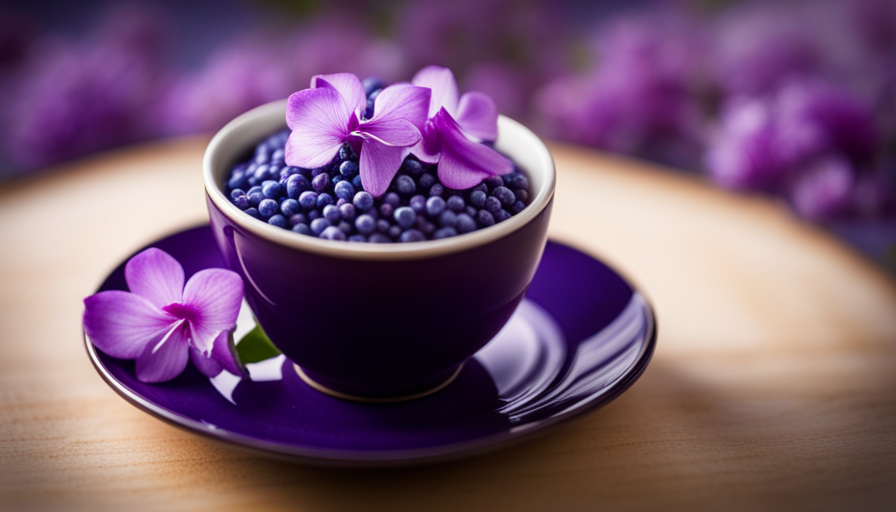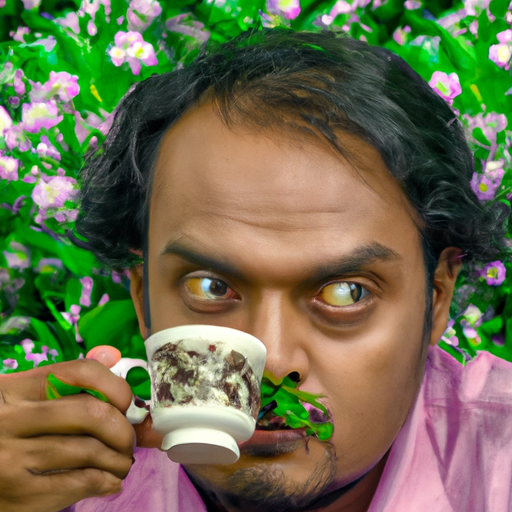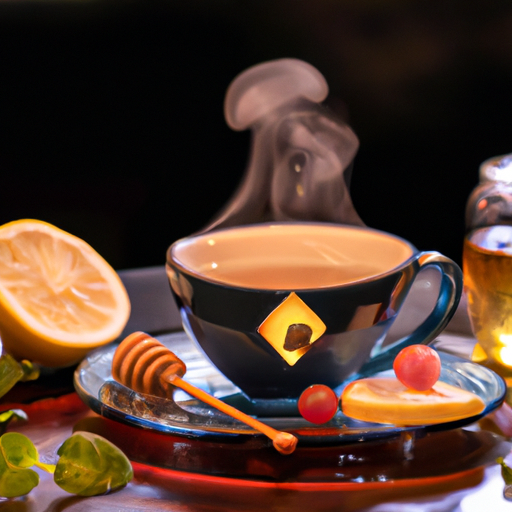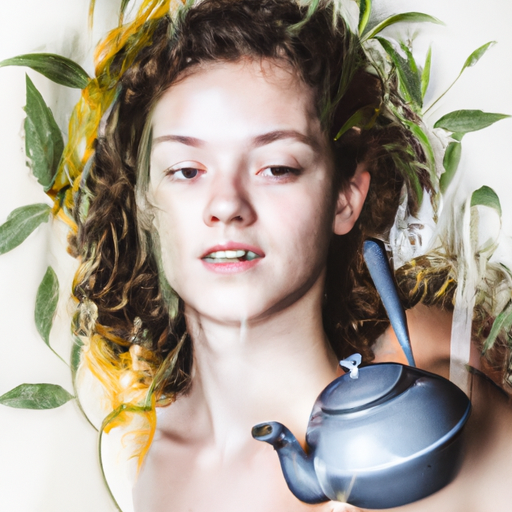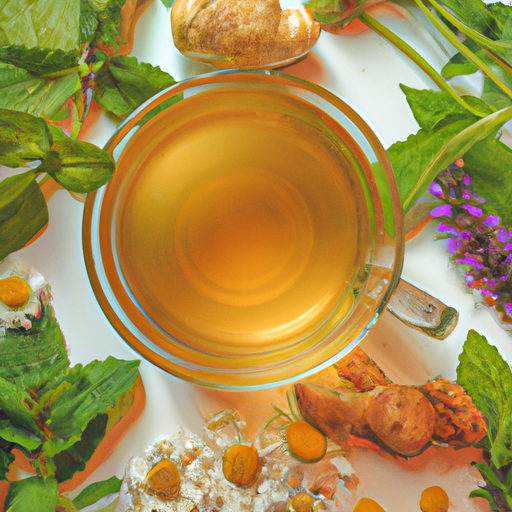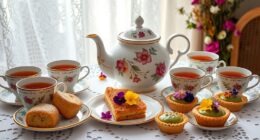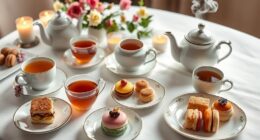Oh, the pleasure of enjoying a steaming cup of tea. There’s a certain sense of comfort in it, isn’t there? But what if I were to inform you that there’s a way to elevate your tea enjoyment? Introducing herbal powder tea, a delightful blend that will not only delight your taste buds but also offer you a range of health benefits.
Making herbal powder tea may sound like a complicated process, but fear not, my fellow tea enthusiasts. With a few simple steps, you’ll be able to create your very own blend of herbal goodness. From choosing your favorite herbs to grinding them into a fine powder, I’ll guide you through each stage of the process.
And once your herbal powder tea is ready, all you need to do is sit back, relax, and enjoy the soothing flavors and nourishing properties it has to offer. So, let’s embark on this aromatic journey together, shall we?
Key Takeaways
- Making herbal powder tea is a simple process that involves choosing herbs, grinding them into a fine powder, and brewing.
- Different herbs have different benefits, such as chamomile for calming and peppermint for digestion.
- Herbal tea blends can be tailored to address specific health concerns, like boosting the immune system.
- Properly labeling, dating, and storing herbal powder teas preserve quality and benefits.
Choose Your Favorite Herbs
Now’s the time to pick out the herbs you love and can’t wait to include in your herbal powder tea! When choosing your favorite herbs, consider the benefits of different herbal teas. For example, chamomile is known for its calming properties and can help with sleep issues, while peppermint is great for digestion and can soothe an upset stomach.
If you have specific health concerns, there are herbal tea blends tailored to address them. For instance, if you’re looking to boost your immune system, try a blend that includes echinacea and elderberry.
Once you’ve decided on the herbs you want to use, gather your ingredients and tools. This will ensure you have everything ready to start making your delicious herbal powder tea.
Gather Your Ingredients and Tools
First, gather all the necessary ingredients and tools you’ll need to whip up this incredible concoction. For the herbal powder tea, you’ll need a variety of herbs such as chamomile, lavender, peppermint, or ginger, depending on your preferences. These herbs offer numerous health benefits, including soothing digestion, promoting relaxation, and boosting immunity.
Additionally, you’ll need a coffee grinder or mortar and pestle to grind the herbs into a fine powder. To add a touch of sophistication, consider using organic or locally sourced herbs for a fresher flavor.
In terms of tools, a fine mesh strainer or tea infuser will come in handy for brewing the tea. Now that you have everything ready, let’s move on to preparing your herbs for grinding.
Prepare Your Herbs for Grinding
Before grinding my herbs for the tea, I make sure they’re completely dry by leaving them out in a cool, dry place for a few days.
Once they’re dry, I carefully crush them using a mortar and pestle until they become a fine powder.
To ensure the purity of my tea, I remove any stems or impurities that may have been mixed in with the herbs.
Dry and Crush Your Herbs
To begin, gather your dried herbs and carefully crush them into a fine powder using a mortar and pestle. Using herbal powder in cooking adds depth and flavor to dishes, making it a versatile ingredient to have in your pantry.
There are different methods of drying herbs, such as air drying or using a dehydrator, but regardless of the method chosen, the herbs should be completely dry before grinding. Crushing the herbs with a mortar and pestle helps release their essential oils and flavors, resulting in a more potent and aromatic powder. Be sure to crush the herbs until they become a fine powder, as larger pieces may not dissolve as well in your tea.
Once the herbs are crushed, you can proceed to the next step of removing any stems or impurities, ensuring a pure and smooth tea experience.
Remove Any Stems or Impurities
Now, take a moment to carefully inspect your crushed herbs, ensuring that you remove any stems or impurities that may have been mixed in. This step is crucial for removing any unwanted elements that could affect the taste or quality of your herbal powder tea.
To help you understand the importance of removing impurities, consider the following points:
- By removing stems and impurities, you’re preserving the freshness of your herbs, ensuring that you get the best flavor and aroma in your tea.
- Removing impurities also helps to eliminate any potential contaminants that may have been present in the herbs.
- The process of removing stems and impurities allows you to create a smoother and more enjoyable tea-drinking experience.
- Taking the time to carefully inspect and clean your crushed herbs demonstrates your commitment to producing a high-quality herbal powder tea.
Now that you’ve removed any stems or impurities, it’s time to proceed to the next step and grind your herbs into a fine powder.
Grind Your Herbs into a Fine Powder
First, you’ll need to pulverize your herbs into a fine powder, just like the saying goes, ‘A little effort goes a long way.’
There are two common methods for grinding herbs: using a mortar and pestle or a coffee grinder. If you prefer a more traditional approach, a mortar and pestle is a great option. Simply place your herbs in the mortar and use the pestle to grind them into a powder. This method allows for better control and preserves the essential oils in the herbs.
On the other hand, if you’re looking for a quicker option, a coffee grinder works just as well. Just make sure it’s clean and dry before use.
Once your herbs are ground into a fine powder, you can move on to the next step of storing your herbal powder tea.
Store Your Herbal Powder Tea
When it comes to storing my herbal powder tea, I always make sure to use airtight containers to preserve its freshness. This helps to maintain the flavor and potency of the herbs over time.
Additionally, I find it helpful to label and date the tea to ensure that I can easily identify and track its shelf life for future use. By following these simple steps, I can enjoy a cup of delicious and beneficial herbal tea whenever I desire.
Use Airtight Containers to Preserve Freshness
To maintain the vibrant flavor and aroma of your herbal powder tea, store it in airtight containers that lock in freshness. Airtight containers are essential for preserving the delicate flavors and aromas of herbal powders. They create a barrier against moisture, light, and air, which can quickly degrade the quality of your tea.
When choosing containers, opt for ones with tight-fitting lids that create a seal. Glass jars with rubber gaskets or metal tins with screw-top lids work well. It’s also important to keep your containers in a cool, dark place, away from direct sunlight and heat sources. This will further protect the tea from degradation.
By storing your herbal powder tea in airtight containers, you can ensure that it stays fresh and flavorful for longer periods of time. Labeling and dating your tea for future use will make it easier to keep track of freshness and rotation.
Label and Date Your Tea for Future Use
Ensure the longevity of your flavorful and aromatic tea by meticulously labeling and dating it for future enjoyment. Properly labeling and dating are essential for herbal powder teas as they help maintain freshness, potency, and quality over time. By following these practices, you can easily identify the tea and its expiration date, ensuring that you consume it within its optimal time frame.
Here are three important reasons to label and date your tea:
-
Organization: Labeling your tea allows for easy identification and prevents confusion when selecting the desired blend.
-
Potency: By dating your tea, you can track its age and potency. This ensures that you consume the tea while it’s still at its peak freshness and effectiveness.
-
Safety: Proper labeling and dating help you avoid consuming expired tea, reducing the risk of ingesting potentially harmful substances.
When it comes to long-term storage, there are various methods you can employ, such as using airtight containers, storing in a cool and dark place, and avoiding exposure to moisture and sunlight. By properly labeling, dating, and storing your herbal powder teas, you can preserve their quality and enjoy their benefits for an extended period.
Now, let’s dive into the next section and discover how to brew and savor your herbal powder tea.
Brew and Enjoy Your Herbal Powder Tea
Savor the rich flavors of your herbal powder tea as you take a moment to indulge in its soothing warmth. Brew and enjoy your herbal powder tea.
Brewing techniques play a crucial role in extracting the maximum taste and benefits from your herbal powder tea. Depending on the herbs you’ve chosen, you can experiment with different brewing methods to find the perfect balance of flavors. Some herbs, like chamomile or lavender, are best steeped in hot water for a few minutes, while others, like ginger or cinnamon, benefit from simmering on low heat for longer periods. By blending different herbal combinations, you can create unique and personalized tea blends that suit your taste preferences and desired health benefits.
Now, let’s explore the benefits of herbal powder tea and discover why it has gained popularity among health-conscious individuals.
Explore the Benefits of Herbal Powder Tea
Discover the incredible health benefits that herbal powder tea has to offer. Herbal powder tea comes in a variety of types, each with its unique benefits. For example, green tea powder is rich in antioxidants that can help protect against cell damage and reduce the risk of chronic diseases like heart disease and cancer.
Matcha powder, on the other hand, contains high levels of catechins, which have been shown to boost metabolism and aid in weight loss. However, it’s important to be aware of potential side effects. Some herbal powders, such as ginseng or licorice root, may interact with certain medications or have hormonal effects.
Additionally, excessive consumption of herbal powder tea may lead to digestive issues or caffeine-related side effects. It’s always best to consult with a healthcare professional before adding herbal powder tea to your daily routine.
Frequently Asked Questions
Can I use fresh herbs instead of dried herbs to make herbal powder tea?
Yes, fresh herbs can be used instead of dried herbs to make herbal powder tea. Using fresh herbs can provide a more vibrant flavor and potentially higher levels of beneficial compounds compared to dried herbs.
How long can I store herbal powder tea before it loses its potency?
To maintain the potency of herbal powder tea, store it in an airtight container in a cool, dark place. Avoid exposure to moisture, heat, and light. Use it within 6-12 months for maximum health benefits.
Is it necessary to grind the herbs into a fine powder, or can I leave them slightly coarse?
It is necessary to grind herbs into a fine powder for herbal powder tea. Grinding herbs finely allows for better extraction of their beneficial compounds, resulting in a more potent and flavorful tea. Proper techniques include using a mortar and pestle or a coffee grinder.
Can I use a regular coffee grinder to grind the herbs, or do I need a specific type of grinder?
Using a regular coffee grinder to grind herbs is like using a butter knife to chop vegetables; it’ll get the job done, but a specific grinder is more efficient. Fresh herbs are preferred for their higher nutrient content and superior flavor in herbal powder tea.
Are there any specific health conditions or allergies that may be affected by consuming herbal powder tea?
Consuming herbal powder tea may have different effects on individuals with specific health conditions and allergies. It is important to consult with a healthcare professional to determine if it is safe for you.
Conclusion
In conclusion, creating an herbal powder tea is a simple and satisfying process. By carefully choosing your favorite herbs and gathering the necessary ingredients and tools, you can embark on a journey of flavors and wellness.
Prepare your chosen herbs with precision, grinding them into a fine powder to enhance their potency. Store your herbal powder tea in airtight containers to preserve its freshness.
Lastly, brew and savor your concoction, allowing the soothing benefits of herbal tea to envelop you. Delight in the diverse flavors while reaping the evidence-based health advantages.


